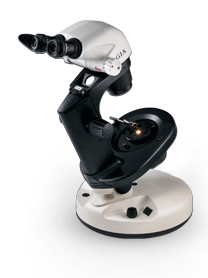In addition to setting standards for determining gem quality and conducting front-line research, GIA protects the gem-buying public by educating gem and jewelry professionals. In fact, GIA was founded more than 80 years ago as an educational institution to help jewelers accurately and ethically communicate gem information to the public.
As you shop for diamonds or gemstones, you may notice that many jewelers proudly display their diplomas and credentials from GIA. Here are descriptions of a few of those internationally recognized credentials and what they mean for you.
- GIA Graduate Gemologist (GG) Diploma:
This is the highest professional credential conferred by GIA. In this respected and world-recognized program, students acquire a comprehensive gemology education across the entire spectrum of diamonds and colored stones. Through extensive practice, they learn how to identify and grade hundreds of common and unusual gemstones and detect the latest treatments and synthetics. They study gemstones from mines to market, and practice their gemological techniques using instruments such as a microscope, polariscope, spectroscope, and other professional gemological equipment. GG diploma recipients achieve the technical knowledge and practical skills necessary for careers as buyers, appraisers, retailers, or senior professionals within the jewelry industry. A GG credential ensures that a highly trained jeweler is present to assist you.
- GIA Graduate Diamonds Diploma:
Graduates from this program have learned the technical expertise needed to grade, buy, and sell diamonds. Students analyze crown, pavilion, and total depth. They learn GIA diamond grading processes to access the 4Cs, and how the 4Cs affect value. They practice using professional diamond grading equipment, and also learn to determine proportions, create plotting diagrams, and detect synthetics and treatments.
- GIA Graduate Colored Stones Diploma:
This program offers a wide array of opportunities to build a knowledge base about colored stones and the colored stones market and identify common and unusual gemstones. Students will use GIA’s Colored Stone Grading System to grade color and clarity; identify synthetics, treatments, and imitations using professional gemological equipment; identify a gemstone’s geographic origin; understand how quality, rarity, and color affect value; determine market factors that impact gem value; and much more.
- GIA Accredited Jewelry Professional (AJP) Diploma:
Graduates from this program learn tremendous product knowledge to help their customers make the most informed purchases possible. Graduates know how to explain the 4Cs of diamond value, and the differences between treated, synthetic and imitation stones to ensure full disclosure. They also know a lot about the lore and attributes of the most popular gemstones, which makes their knowledge indispensable when you’re making a purchasing decision.
- GIA Graduate Pearls Diploma:
GIA’s Graduate Pearls diploma program teaches students about GIA’s 7 Pearl Value Factors™, which helps them evaluate, buy, and sell pearls. After graduation, students can effectively communicate the relationship of beauty, benefits, value and quality to pearl-loving customers. Graduates know how to distinguish the differences in pearls, including cultured pearls, aiding consumers in finding exactly which pearl they’re looking for.
- GIA Jewelry Design & Technology (JDT) Diploma:
Ready to learn cutting-edge jewelry design in a cutting-edge environment? That’s what you’ll experience in the GIA Jewelry Design & Technology program. You’ll learn CAD/CAM (computer-aided design/computer-aided manufacturing), rapid prototyping, and other technologies and innovations that are revolutionizing the gem and jewelry industry. In addition, understand common manufacturing processes; learn important jewelry engineering concepts; troubleshoot problems arising from the design and manufacture of pieces; and more. At the conclusion of the program, you will have a portfolio of your jewelry design renderings and rapid prototypes. (Offered at GIA Carlsbad Campus)
- GIA Graduate Jeweler (GJ) Diploma:
If you’re looking to have a custom piece of jewelry made, or need to repair a long-worn favorite, look for a jeweler with a GIA Graduate Jeweler diploma. This program teaches students how to transform precious metals and gemstones into beautiful pieces of jewelry. Students are trained at a workbench, just as professional jewelers work, learning skills such as sizing, soldering, finishing and polishing. Students are introduced to the latest technologies, like laser welding with pulse profiling, and acquire the time-honored skills of hand fabrication, custom order and jewelry repair. (Offered at GIA Carlsbad Campus)
Custom Field: Array
